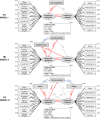Two-years mothering into the pandemic: Impact of the three COVID-19 waves in the Argentinian postpartum women's mental health
- PMID: 40106445
- PMCID: PMC11922242
- DOI: 10.1371/journal.pone.0294220
Two-years mothering into the pandemic: Impact of the three COVID-19 waves in the Argentinian postpartum women's mental health
Abstract
The COVID-19 pandemic disproportionately affects certain vulnerable groups, including postpartum women. Thus, this work aimed to analyze the mental health evolution in Argentinian postpartum women during the first three waves of COVID-19 and its determinants. In this repeated cross-sectional study, data were collected during the three waves of COVID-19: May-July/2020 (n = 319), April-August/2021 (n = 340), and December/2021- March/2022 (n = 341). Postpartum depression, insomnia, and perceived stress symptoms were assessed using valid instruments. Statistical analyses included multivariate logistic regression, analysis of variance, and structural equation modeling to test for temporal trends in mental health indicators during the pandemic and to identify their determinants. The prevalence rates of postpartum depression and insomnia rose from 37% to 60% and 46% to 62%, respectively. In contrast, pandemic-related stress decreased. The following negative factors for maternal mental health were identified: unemployment status, lack of medical support, reduced family size, remote working, advanced maternal age, late postpartum, multiparity, and living in the least developed region of Argentina. Structural equation modeling confirmed a process of pandemic-stress adaptation, although there is a persistent increment of postpartum depression and consequent increased insomnia. Postpartum women's mental health worsened during the COVID-19 pandemic. Although women have become more able to cope and perceive less pandemic-related stress, its social and economic impact still persists and puts them at higher psychological risk. Thus, health systems must seek protection of women of reproductive age against negative factors in order to cope with pandemic-related events.
Copyright: © 2025 Miranda et al. This is an open access article distributed under the terms of the Creative Commons Attribution License, which permits unrestricted use, distribution, and reproduction in any medium, provided the original author and source are credited.
Conflict of interest statement
The authors have declared that no competing interests exist.
Figures




References
-
- Kassaeva P, Belova E, Shashina E, Shcherbakov D, Makarova V, Ershov B, et al.. Anxiety, depression, and other emotional disorders during the COVID-19 pandemic: a narrative review of the risk factors and risk groups. Encyclopedia. 2022;2(2):912–27. doi: 10.3390/encyclopedia2020060 - DOI
-
- Miranda AR MD, Scotta AV MD, Cortez MV PhD, Soria EA PhD. Triggering of postpartum depression and insomnia with cognitive impairment in Argentinian women during the pandemic COVID-19 social isolation in relation to reproductive and health factors. Midwifery. 2021;102:103072. doi: 10.1016/j.midw.2021.103072 - DOI - PMC - PubMed
MeSH terms
LinkOut - more resources
Full Text Sources
Medical
Miscellaneous

